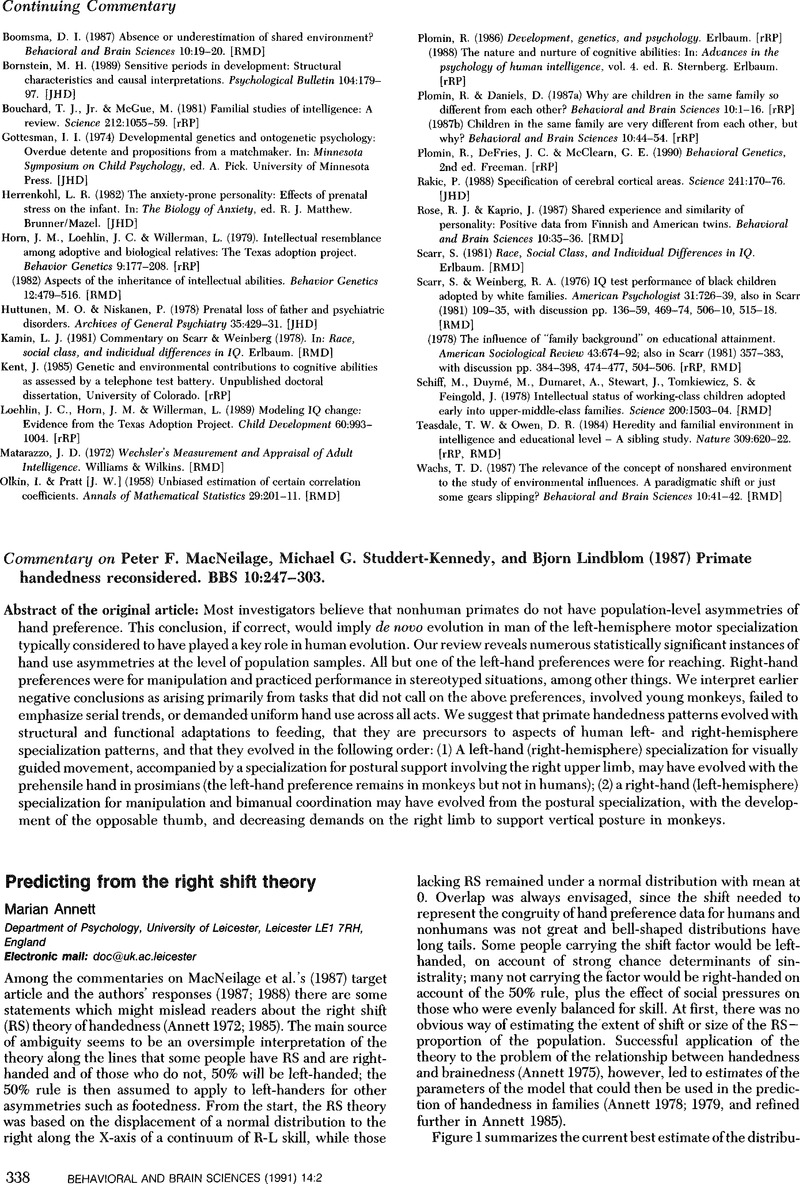Crossref Citations
This article has been cited by the following publications. This list is generated based on data provided by Crossref.
Karmiloff-Smith, Annette
and
Johnson, Mark H.
1991.
Constructivism without tears.
Behavioral and Brain Sciences,
Vol. 14,
Issue. 4,
p.
566.
Tomasello, Michael
1991.
Objects are analogous to words, not phonemes or grammatical categories.
Behavioral and Brain Sciences,
Vol. 14,
Issue. 4,
p.
575.
Connolly, Kevin J.
and
Manoel, Edison de J.
1991.
Hierarchies and tool-using strategies.
Behavioral and Brain Sciences,
Vol. 14,
Issue. 4,
p.
554.
Powers, David M. W.
1991.
Goal directed behavior in the sensorimotor and language hierarchies.
Behavioral and Brain Sciences,
Vol. 14,
Issue. 4,
p.
572.
Noble, William
and
Davidson, Iain
1991.
Evolving remembrance of times past and future.
Behavioral and Brain Sciences,
Vol. 14,
Issue. 4,
p.
572.
Bickerton, Derek
1991.
Syntax is not as simple as it seems.
Behavioral and Brain Sciences,
Vol. 14,
Issue. 4,
p.
552.
Lieberman, Philip
1991.
Speech and brain evolution.
Behavioral and Brain Sciences,
Vol. 14,
Issue. 4,
p.
566.
Anderson, James R.
1991.
Making the best use of primate tool use?.
Behavioral and Brain Sciences,
Vol. 14,
Issue. 4,
p.
551.
Deacon, Terrence W.
1991.
Anatomy of hierarchical information processing.
Behavioral and Brain Sciences,
Vol. 14,
Issue. 4,
p.
555.
Wynn, Thomas
1991.
The comparative simplicity of tool-use and its implications for human evolution.
Behavioral and Brain Sciences,
Vol. 14,
Issue. 4,
p.
576.
MacNeilage, Peter F.
1991.
Linguistic and manual evolution.
Behavioral and Brain Sciences,
Vol. 14,
Issue. 4,
p.
568.
Matsuzawa, Tetsuro
1991.
Nesting cups and metatools in chimpanzees.
Behavioral and Brain Sciences,
Vol. 14,
Issue. 4,
p.
570.
Thatcher, Robert W.
1991.
Are rhythms of human cerebral development “traveling waves”?.
Behavioral and Brain Sciences,
Vol. 14,
Issue. 4,
p.
575.
Jacobs, Bob
1991.
Neurobiology and language acquisition: Continuity and identity.
Behavioral and Brain Sciences,
Vol. 14,
Issue. 4,
p.
565.
Grafman, Jordan
and
Hendler, James
1991.
Planning and the brain.
Behavioral and Brain Sciences,
Vol. 14,
Issue. 4,
p.
563.
Golinkoff, Roberta Michnick
Hirsh-Pasek, Kathryn
and
Reeves, Lauretta
1991.
Have four module and eat it too!.
Behavioral and Brain Sciences,
Vol. 14,
Issue. 4,
p.
561.
Fragaszy, Dorothy Munkenbeck
1991.
A comparative view of object combination and tool use: Moving ahead.
Behavioral and Brain Sciences,
Vol. 14,
Issue. 4,
p.
557.
Gómez, Juan C.
and
Sarriá, Encarnación
1991.
Gestures, persons and communication: Sociocognitive factors in the development and evolution of linguistic abilities.
Behavioral and Brain Sciences,
Vol. 14,
Issue. 4,
p.
562.
Greenfield, Patricia M.
1991.
From hand to mouth.
Behavioral and Brain Sciences,
Vol. 14,
Issue. 4,
p.
577.
Gibson, Kathleen R.
1991.
Continuity versus discontinuity theories of the evolution of human and animal minds.
Behavioral and Brain Sciences,
Vol. 14,
Issue. 4,
p.
560.





